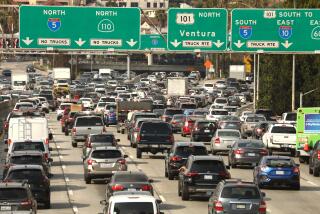Editorial: Digital billboards on top of rideshare vehicles? No thanks

As if drivers in Los Angeles needed another distraction.
The streets have already been made vastly less safe with the proliferation of cellphones, complicated touchscreen vehicle displays and digital billboards alongside freeways — all competing for drivers’ attention that should be focused on the road.
Now, a tech startup called Firefly has rolled out yet another shiny object: flashing digital signs affixed to the roofs of private vehicles being used for Uber and Lyft ride-hailing services. The sign boxes are roughly the size of a rooftop cargo carrier and display a stream of advertisements powered by the car’s battery.
In typical Silicon Valley fashion, Firefly has been installing digital signage on rideshare vehicles in Los Angeles despite the fact that City Atty. Mike Feuer’s office told the company last year that the signs are illegal under city and state law. (The company disputes that.) Now, Councilman Bob Blumenfield, who has battled mobile sign companies before, wants to pass an ordinance to make it crystal clear that the signs are not allowed on Ubers, Lyfts and taxicabs.
Yes, please. Los Angeles doesn’t need to be bombarded with more in-your-face advertisements, especially if they’re distracting and dangerous.
Enter the Fray: First takes on the news of the minute »
Drivers can earn about $300 a month by carrying the Firefly signs on their cars, so they are — understandably — opposed to the ban. Gig economy drivers already have a tough time making ends meet, as they are independent contractors responsible for car payments, vehicle maintenance and fuel, and yet are without the protections or benefits they would receive if they were employees. Drivers argue that they especially need the digital signage revenue now because Uber and Lyft have slashed their pay.
But why should the public have to put up with bright flashing digital signs on the roads because Uber and Lyft drivers say the companies won’t pay a living wage? Public safety on the streets shouldn’t be imperiled to subsidize the labor force of multibillion-dollar corporations. Research on the effects of large digital billboards on the side of roads suggests that they interrupt drivers’ focus and can increase the risk of a crash.
Councilman Paul Koretz has proposed creating a pilot program that would allow digital rooftop advertising, but just on taxis. This is a nod to cabbies who have struggled to compete with the less-strictly-regulated ride-hailing services. But digital signs are a blight and a distraction whether they are on taxis or Ubers. The problem is the sign itself, not which car it sits on.
Besides, if taxis are allowed to install digital signs, Uber and Lyft drivers are going to expect the same right. Then drivers for all the other gig economy delivery services will want to slap the blinking billboards on the roofs of their private vehicles, adding thousands of roving commercials across the city. And why shouldn’t the rest of us — even if we’re just driving our own cars to work — be allowed in on the advertising action as well?
Follow the Opinion section on Twitter @latimesopinion and Facebook
More to Read
A cure for the common opinion
Get thought-provoking perspectives with our weekly newsletter.
You may occasionally receive promotional content from the Los Angeles Times.










